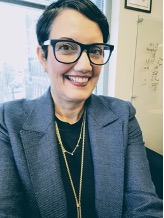Improving Mental Health Care, with the Help of an AI Teammate
Jan 04, 2024 —

While increasing numbers of people are seeking mental health care, mental health providers are facing critical shortages. Now, an interdisciplinary team of investigators at Georgia Tech, Emory University, and Penn State aim to develop an interactive AI system that can provide key insights and feedback to help these professionals improve and provide higher quality care, while satisfying the increasing demand for highly trained, effective mental health professionals.
A new $2,000,000 grant from the National Science Foundation (NSF) will support the research.
The research builds on previous collaboration between Rosa Arriaga, an associate professor in the College of Computing and Andrew Sherrill, an assistant professor in the Department of Psychiatry and Behavioral Sciences at Emory University, who worked together on a computational system for PTSD therapy.
Arriaga and Christopher Wiese, an assistant professor in the School of Psychology will lead the Georgia Tech team, Saeed Abdullah, an assistant professor in the College of Information Sciences and Technology will lead the Penn State team, and Sherrill will serve as overall project lead and Emory team lead.
The grant, for “Understanding the Ethics, Development, Design, and Integration of Interactive Artificial Intelligence Teammates in Future Mental Health Work” will allocate $801,660 of support to the Georgia Tech team, supporting four years of research.
“The initial three years of our project are dedicated to understanding and defining what functionalities and characteristics make an AI system a 'teammate' rather than just a tool,” Wiese says. “This involves extensive research and interaction with mental health professionals to identify their specific needs and challenges. We aim to understand the nuances of their work, their decision-making processes, and the areas where AI can provide meaningful support.In the final year, we plan to implement a trial run of this AI teammate philosophy with mental health professionals.”
While the project focuses on mental health workers, the impacts of the project range far beyond. “AI is going to fundamentally change the nature of work and workers,” Arriaga says. “And, as such, there’s a significant need for research to develop best practices for integrating worker, work, and future technology.”
The team underscores that sectors like business, education, and customer service could easily apply this research. The ethics protocol the team will develop will also provide a critical framework for best practices. The team also hopes that their findings could inform policymakers and stakeholders making key decisions regarding AI.
“The knowledge and strategies we develop have the potential to revolutionize how AI is integrated into the broader workforce,” Wiese adds. “We are not just exploring the intersection of human and synthetic intelligence in the mental health profession; we are laying the groundwork for a future where AI and humans collaborate effectively across all areas of work.”
Collaborative project
The project aims to develop an AI coworker called TEAMMAIT (short for “the Trustworthy, Explainable, and Adaptive Monitoring Machine for AI Team”). Rather than functioning as a tool, as many AI’s currently do, TEAMMAIT will act more as a human teammate would, providing constructive feedback and helping mental healthcare workers develop and learn new skills.
“Unlike conventional AI tools that function as mere utilities, an AI teammate is designed to work collaboratively with humans, adapting to their needs and augmenting their capabilities,” Wiese explains. “Our approach is distinctively human-centric, prioritizing the needs and perspectives of mental health professionals… it’s important to recognize that this is a complex domain and interdisciplinary collaboration is necessary to create the most optimal outcomes when it comes to integrating AI into our lives.”
With both technical and human health aspects to the research, the project will leverage an interdisciplinary team of experts spanning clinical psychology, industrial-organizational psychology, human-computer interaction, and information science.
“We need to work closely together to make sure that the system, TEAMMAIT, is useful and usable,” adds Arriaga. “Chris (Wiese) and I are looking at two types of challenges: those associated with the organization, as Chris is an industrial organizational psychology expert — and those associated with the interface, as I am a computer scientist that specializes in human computer interaction.”
Long-term timeline
The project’s long-term timeline reflects the unique challenges that it faces.
“A key challenge is in the development and design of the AI tools themselves,” Wiese says. “They need to be user-friendly, adaptable, and efficient, enhancing the capabilities of mental health workers without adding undue complexity or stress. This involves continuous iteration and feedback from end-users to refine the AI tools, ensuring they meet the real-world needs of mental health professionals.”
The team plans to deploy TEAMMAIT in diverse settings in the fourth year of development, and incorporate data from these early users to create development guidelines for Worker-AI teammates in mental health work, and to create ethical guidelines for developing and using this type of system.
“This will be a crucial phase where we test the efficacy and integration of the AI in real-world scenarios,” Wiese says. “We will assess not just the functional aspects of the AI, such as how well it performs specific tasks, but also how it impacts the work environment, the well-being of the mental health workers, and ultimately, the quality of care provided to patients.”
Assessing the psychological impacts on workers, including how TEAMMAIT impacts their day-to-day work will be crucial in ensuring TEAMMAIT has a positive impact on healthcare worker’s skills and wellbeing.
“We’re interested in understanding how mental health clinicians interact with TEAMMAIT and the subsequent impact on their work,” Wiese adds. “How long does it take for clinicians to become comfortable and proficient with TEAMMAIT? How does their engagement with TEAMMAIT change over the year? Do they feel like they are more effective when using TEAMMAIT? We’re really excited to begin answering these questions.


Written by Selena Langner
Contact: Jess Hunt-Ralston





